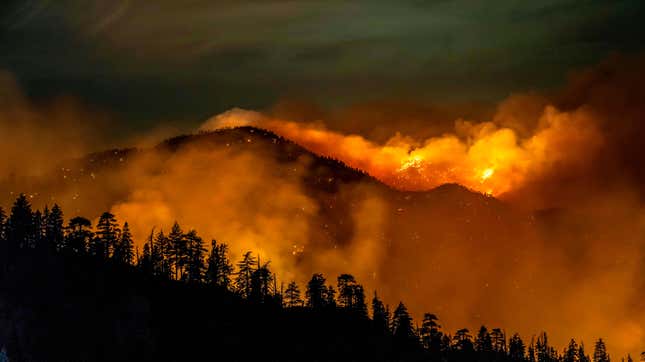
In August, researchers warned we would have to add “gigafire” to the lexicon to describe wildfires in California. Now, it’s become a part of the history books.
On Monday, the August Complex in Northern California surpassed 1 million acres burned, the threshold for a gigafire. It makes the first gigafire in modern history for California, more than doubling the total acreage burned for the previous record-setting fire.
The August Complex is a series of blazes that on their own would be in the record books. But the fires that began in the freak mid-August lightning siege have merged into one monster fire that’s now larger than the entire state of Rhode Island. The fire complex is only 54% contained and burning through rugged, remote mountains across seven counties. Conditions are conducive for it to keep burning, with Cal Fire noting that “temperatures will remain 10 to 15 degrees above normal and relative humidity values will fall into the teens” on Monday.
The superlatives attached to the August Complex Fire are many. It’s more than double the size of the Mendocino Complex, a similar conglomeration of fires that burned in 2018 was the largest wildfire ever recorded in California before the August Complex Fire. Then there’s the whole gigafire thing, a term scientists use to describe fires that burn more than 1 million acres. Australia saw a gigafire during its bushfire season from hell earlier this year. While there have been past examples of 1 million-plus acre fires in the U.S., this is the first in more than a decade. The most recent wildfire that burned more than 1 million acres on the National Interagency Fire Center’s list of “historically significant” blazes was 2004's Taylor Complex in Alaska.
These types of explosive, out-of-control fires are likely to become more common as the world heats up, though. An analysis by Climate Central found that large wildfires are three times more common across the West since the 1970s while wildfire season is more than three months longer. That’s with just 1.8 degrees Fahrenheit (1 degree Celsius) of warming. The future is expected to get hotter and drier, creating conditions even more conducive to wildfires. At the same time, decades of forest mismanagement and explosive population growth at the edge of the wildland-urban interface has made matters even worse. Those trends both raise the risk of fires igniting thanks to human infrastructure and destructiveness with so many people and homes in harm’s way.
That trend is particularly acute in California. There, 17 of the 20 largest fires have occurred since 2000, according to data kept by state agency Cal Fire. That includes a staggering four of the top five in 2020 alone. Three of the top 20 most destructive fires—ranked by structures destroyed—have also occurred this year. With Santa Ana and Diablo wind season still in full effect, the chance of new dangerous fires igniting or current blazes spreading is a very real risk.
It’s never been clearer we need to rethink everything from how electricity is delivered to how forests are managed and where people live in them to how to rapidly draw down carbon emissions. Otherwise, the August Complex may be the first of more gigafires to come in California and across the West.
Correction, 10/5/20, 1:55 p.m. ET: This post reversed the conversion between Fahrenheit and Celsius. It has been updated to reflect the proper conversion.